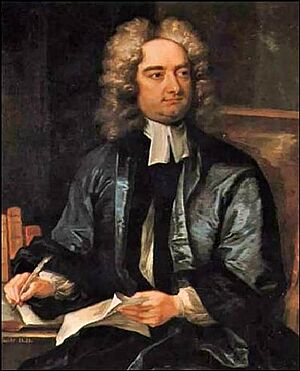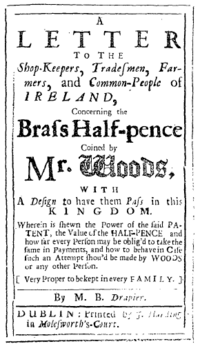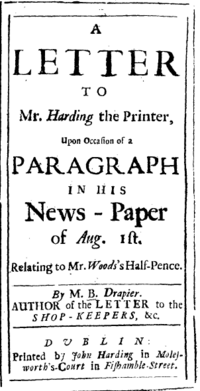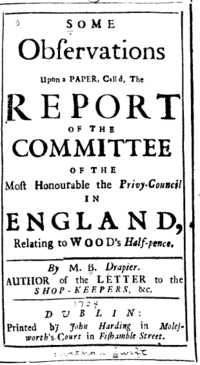Drapier's Letters facts for kids
Drapier's Letters is a group of seven short books, called pamphlets. They were written between 1724 and 1725 by Jonathan Swift. He was a religious leader in Dublin, Ireland. Swift wrote these letters to get Irish people to stand up against new copper coins. He believed these coins were of poor quality.
An English businessman named William Wood was given permission to make these coins. Swift thought this permission was unfair. In his letters, Swift argued that Ireland should be in charge of its own money. He also said Ireland should be independent from Britain. Because it was a risky topic, Swift used a fake name, M. B., Drapier, to stay safe.
Even though the Irish Parliament, pushed by the British Parliament, said the letters were wrong, they still made people angry about Wood's coins. People started to refuse the coins all over Ireland. This forced the government to take back Wood's permission. Swift became a hero to many Irish people for standing up to British power. He was even called "Our Irish Copper-Farthen Dean."
The first full collection of Drapier's Letters was published in 1734. Today, these letters are seen as very important political writings by Swift. They are as famous as his other works like Gulliver's Travels and A Modest Proposal.
Contents
Why the Letters Were Written
The Problem with New Coins
In 1722, William Wood, who made hardware, got special permission. This permission allowed him to make copper coins for Ireland. He could make coins worth up to £108,000. This was a lot of money back then. Wood got this permission by making a secret payment of £10,000 to the Duchess of Kendal. She was a close friend of King George I.
People in Ireland said Wood's copper coins were too light. They also said the coins were too small and made from cheap metal. Even though tests in Britain said the coins were fine, many Irish people disagreed.
Ireland's Concerns
The main worry in Ireland was not a lack of copper coins. It was that these new, poor-quality coins would flood the Irish economy. People feared that good silver and gold coins would disappear from use. Since Ireland did not control the making of these new copper coins, they could not check their quality or how many were made.
This coin issue was part of a bigger problem. Ireland wanted its own national bank. It also wanted the power to make its own money. Wood's coins became a way for Irish people to show they wanted more control over their economy.
Swift Steps In
The problem with Wood's coins became a fight. It was between British Prime Minister Robert Walpole and Irish leaders. The Irish leaders tried to stop the coins, but nothing worked. People worried that soldiers in Ireland might even be paid with the new coins. If soldiers used them, shops would have to accept them. This could hurt businesses or cause trouble.
Irish leaders asked Jonathan Swift for help. He was asked to write pamphlets against Wood's coins. Swift was already known for caring about the Irish people. He had written other political pamphlets before. One of his earlier writings suggested that Irish people should use goods made in Ireland. This had upset British officials.

Swift looked at the problems Wood's bad coins would cause for Ireland's money. He wrote about this in his first pamphlet, A Letter to the Shop-keepers (1724). In this letter, Swift pretended to be "the Drapier." This was a common Irish person, a skilled cloth seller, and a religious man. The Drapier was loyal to his church and to the King of Ireland.
Swift used this fake name for two reasons. First, it helped him hide from possible punishment. Second, it allowed him to seem like an ordinary person. This helped him connect with the common people of Ireland. Many people in Ireland, including important officials, knew Swift was the author. But there was no clear legal proof. This made it hard for the government to arrest him.
Over about a year, four more pamphlets came out. They were full of strong words against Wood and his coins. The pamphlets worked! Public opinion turned strongly against Wood's coins. By 1725, his permission to make coins was taken away. The government even offered a reward of £300 to find out who the Drapier was. But Swift was never arrested. The strong support from the Irish people for the "Drapier" helped convince the government to withdraw the coins.
Ireland's Freedom Ideas
Swift knew that the Duchess of Kendal was involved in selling the coin permission to Wood. But he rarely mentioned her in the letters. Instead, he mostly blamed Wood. The Drapier always said he was loyal to the King. But his words still led to accusations of "treason" (betraying the country).
In his third and fourth letters, Swift argued that Ireland should be independent from British control. He said this did not mean being disloyal to the King. This argument made the British Prime Minister Walpole very angry. The Drapier was accused of "treason to the English Parliament." This only made Irish people more upset. They agreed with Swift that they owed loyalty only to their King, not to the English Parliament.
The Pamphlets Explained
The first three pamphlets were meant to finish the argument. But when the British official Lord Carteret came to Ireland and offered a reward for the Drapier, Swift felt he needed to write a fourth. The fifth letter was written when the coin problem was at its peak. The last two letters were published after the coin problem ended.
To the Shop-keepers
The Drapier's first letter, To the Shop-keepers, Tradesmen, Farmers, and Common-People of Ireland, came out in March 1724. It quickly became very popular. Swift said over 2,000 copies were sold in Dublin.
The Drapier starts by telling his readers they have a duty as "Christians, as parents, and as lovers of your country." He explains the problem with Wood's coins. Then he suggests people refuse to use them, just like he suggested in an earlier pamphlet. The Drapier often talks about how humble he is. He uses religious and old stories to make fun of Wood. He blames Wood for the coins, saying, "It is no treason to rebel against Mr Wood."
The letter uses a lot of religious language, like Swift's sermons. The Drapier warns people about a danger to their economy and their spirits. He says Wood's coins would ruin Ireland's economy. Good coins would disappear, and farmers would not be able to pay their rent. This would lead to more poverty and less food.
Swift's descriptions of the economic harm were very strong. But many believe they were based on truth. The Drapier focuses on Wood, not the King. But he hints that Wood bribed people close to the King. Still, the Drapier always shows respect for the King. He makes Wood seem like the main target. This made Irish people feel safe to stand up against "an insignificant hardware man."
To Mr Harding
The Drapier's second letter, A Letter to Mr. Harding the Printer, was printed in August 1724. It was a response to the British government testing Wood's coin.
In this letter, the Drapier blames the Whig political party for Wood getting his permission. He attacks a report from the British government that defended Wood's coins. The Drapier says this report is just Wood's lies. He calls the people who wrote it "Betrayers of their Country."
The Drapier does not directly attack Isaac Newton's test of the coins. Instead, he questions how the test was done and who testified. He says Wood's offers to lower the coin amount were just propaganda. The Drapier also accuses Wood of "High Treason" for trying to force people to accept copper coins. He says the King does not have the power to do that.
The Drapier is careful not to directly accuse the King. He says the King cannot force people to take copper money. He points out that Ireland's laws say only gold or silver coins are official. The Drapier compares the King's power to make money with Wood's small power. This makes the King seem less powerful. But the Drapier always says the King would never harm Ireland.
After this letter, many bankers and merchants agreed not to accept Wood's coins. The British government ordered the coins to be used. But Irish officials did not follow the orders. This stopped the coins from being used.
To the Nobility and Gentry
The Drapier's third letter, To the Nobility and Gentry of the Kingdom of Ireland, was printed in August 1724. It continued to discuss the same issues as the second letter. The Drapier uses his humble image to appeal to the pride of the Irish nobles.
Most of this letter responds to the British government's report defending Wood's coins. This report was not officially published by Parliament. This allowed the Drapier to question its truthfulness.
The Drapier claims that Wood showed "utter contempt" for Ireland's political leaders. He says Wood would use his coins and the report to make fun of them. The letter also argues about Britain's right to rule Ireland.
The Drapier reminds readers that Wood had a similar coin problem in Massachusetts. The people there completely refused his coins. The Drapier asks, "Were not the People of Ireland born as Free as those of England?"
The letter ends with the image of David fighting the giant Goliath. Wood is the giant, and the Drapier is the small merchant. This image was very powerful for the people. The third letter clearly states Swift's idea that political power comes from the people's agreement. It also argued against a British law that took away Ireland's independence. Swift always fought for Ireland to be more self-reliant.
To the Whole People of Ireland
The Drapier's fourth letter, To the Whole People of Ireland, was published in October 1724. It was written as Lord Carteret arrived in Dublin. The Drapier pretends that Carteret's arrival was just a rumor.
This letter responds to accusations against the Irish. These included claims of being disloyal to the King. A big part of the letter argues for the political freedom of the Irish people. This argument was why the Drapier was accused of trying to challenge British rule. The Drapier carefully balances loyalty and disloyalty. He says the Irish are loyal only to their King, who is "King of Ireland," but not to England.
The Drapier states: "I M.B. Drapier, desire to be excepted, for I declare, next under God, I depend only on the King my sovereign, and on the laws of my own country." He even says he would fight against the English if they rebelled against his King.
The Drapier turns the accusations of treason back on Wood and his supporters. He says they are the real traitors. He believes God supports the Irish people. But he says the Irish must stand up against the "treasonous British."
The most famous part of the Drapier's Letters is in this letter: "by the laws of GOD, of NATURE, of NATIONS, and of your own COUNTRY, you ARE and OUGHT to be as FREE a people as your brethren in England." This idea comes from the philosopher John Locke. Locke wrote that people have the right to resist their government if their rights are taken away.
Another argument in this letter was about an old law called Poynings' Law. This law allowed the British Parliament to control Ireland's laws. The Drapier argued that Ireland was a separate kingdom, not just a territory controlled by this law.
Lord Carteret read parts of this letter to the Irish government. He said they were treasonous. The printer, Harding, was arrested. A £300 reward was offered for the Drapier's identity. But the people of Ireland stood by the writer. Their support protected Swift.
To Viscount Molesworth
The Drapier's fifth letter, A Letter To the Honourable the Lord Viscount Molesworth, was published in December 1724. This letter gives the most details about the Drapier's fake life story.
This letter is seen as the final attack in the Drapier's fight against Wood's coins. Swift published it to make sure the government would keep its promise to remove the coins. It also celebrated the release of Harding, the printer, from jail.
The Drapier starts his letter with quotes from the Bible and an old Roman poem. He wants to show his innocence by appealing to people's reason and religious feelings. He says: "I foolishly disdained to have Recourse to Whining, Lamenting, and Crying for Mercy, but rather chose to appeal to Law and Liberty and the common Rights of Mankind."
Some say Swift wrote this letter to brag. But it also encouraged the Irish to remember what Walpole, Wood, and the British Parliament had done. The Drapier says he is on the right side of the argument.
This letter also aimed to bring different groups of people together. By writing to Lord Molesworth, a nobleman, the Drapier united all Irish people for a common cause. He was calling for more support for Ireland's freedom.
The letter also celebrates the Drapier not being caught. It celebrates his victory over William Whitshed, the judge who tried to convict Harding. Swift had secretly written another letter that helped convince the jury to free Harding. The Drapier hints at this in the letter. This letter is considered one of the best written of all the Letters.
To the Lord Chancellor Middleton
The sixth letter, To the Lord Chancellor Middleton, was a private letter from Jonathan Swift to Lord Midleton. It was written in October 1724. It is not a true "Drapier" letter because Swift signed it with his own name.
Swift wrote this letter to make sure Midleton would continue to oppose Wood's coins. Swift used his position as a religious leader to show that the Drapier's intentions were good. He repeated many of the earlier arguments to get Midleton to openly support the Drapier's actions. Swift also admitted he was actively working against the coins.
An Humble Address
The Drapier's last letter, An Humble Address to Both Houses of Parliament, was finished in June 1725. It was written before Wood's coin permission was taken away. It was stopped from being printed when Swift heard the coins were withdrawn. This letter was not published for 10 years.
The letter challenges the Irish Parliament to investigate how Wood got his permission. Most people in power knew it was due to bribery. The letter aimed to unite the Irish people to fight for more economic freedom. The Drapier says Ireland was losing out, and England was gaining.
The Drapier talks about many issues Swift cared about. These included landowners who did not live in Ireland, importing goods from Britain, and favoring Englishmen for jobs in Ireland. But these specific issues were less important than Ireland's independence and unity. Some believe Swift focused on writing Gulliver's Travels after this, where he explored similar ideas.
How They Were Published
John Harding published the first four letters. He also published the fifth after he was released from jail. After Harding died, George Faulkner became Swift's main publisher in Ireland. The letters To the Lord Chancellor Middleton and An Humble Address were copied from Swift's handwritten notes and then printed with the other letters. The Drapier's Letters were first collected and published all together by Faulkner in 1735.
Faulkner advertised his plan to publish Swift's collected works in 1733. This led to a lawsuit because another publisher in London, Benjamin Motte, had the rights to many of Swift's works. Even though the Drapier's Letters were not copyrighted, the full collection was stopped from being published in England. It is not clear if Swift allowed Faulkner to publish the works to help an Irish publisher compete, or if Faulkner published them without Swift's permission.
Images for kids







